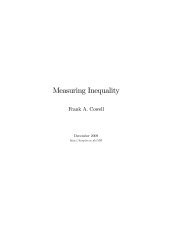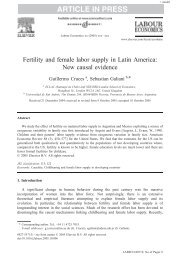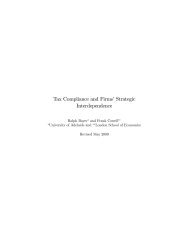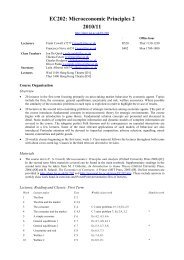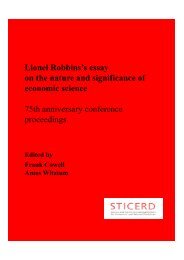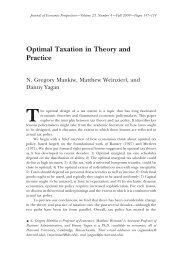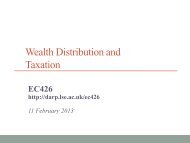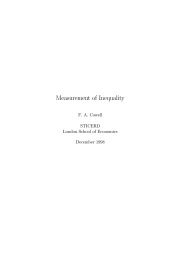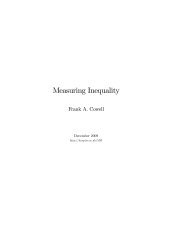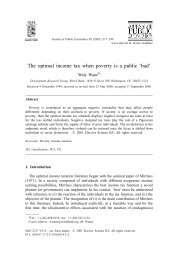Uncertainty and Risk - DARP
Uncertainty and Risk - DARP
Uncertainty and Risk - DARP
Create successful ePaper yourself
Turn your PDF publications into a flip-book with our unique Google optimized e-Paper software.
Microeconomics CHAPTER 8. UNCERTAINTY AND RISK<br />
Exercise 8.13 Consider a competitive, price-taking …rm that confronts one of<br />
the following two situations:<br />
“uncertainty”: price p is a r<strong>and</strong>om variable with expectation p.<br />
“certainty”: price is …xed at p.<br />
It has a cost function C(q) where q is output <strong>and</strong> it seeks to maximise the<br />
expected utility of pro…t.<br />
1. Suppose that the …rm must choose the level of output before the particular<br />
realisation of p is announced. Set up the …rm’s optimisation problem <strong>and</strong><br />
derive the …rst- <strong>and</strong> second-order conditions for a maximum. Show that,<br />
if the …rm is risk averse, then increasing marginal cost is not a necessary<br />
condition for a maximum, <strong>and</strong> that it strictly prefers “certainty” to “uncertainty”.<br />
Show that if the …rm is risk neutral then the …rm is indi¤erent<br />
as between “certainty” <strong>and</strong> “uncertainty”.<br />
2. Now suppose that the …rm can select q after the realisation of p is announced,<br />
<strong>and</strong> that marginal cost is strictly increasing. Using the …rm’s<br />
competitive supply function write down pro…t as a function of p <strong>and</strong> show<br />
that this pro…t function is convex. Hence show that a risk-neutral …rm<br />
would strictly prefer “uncertainty” to “certainty”.<br />
Outline Answer:<br />
1. Pro…t is given by<br />
:= pq<br />
C(q)<br />
where p is a r<strong>and</strong>om variable. Maximising expected utility of pro…t Eu()<br />
by choice of q requires the FOC<br />
E(u ()p) E(u ())C q = 0<br />
where u () is the …rst derivative of u(). This will represent a maximum<br />
if<br />
d 2 Eu<br />
dq 2 < 0:<br />
We …nd that this implies<br />
E(u [p C q ] 2 ) E(u )C qq < 0:<br />
Notice that since the …rst term is negative for a risk-averse …rm then the<br />
condition can be satis…ed not only if C qq > 0 but also if C qq < 0 <strong>and</strong> jC qq j<br />
is not too large. Now consider transforming p to bp thus: bp = (1 )p + p<br />
then bp has the same mean as p but is less dispersed. Maximised utility for<br />
the r<strong>and</strong>om variable bp is<br />
Eu([(1 )p + p]q C(q ))<br />
where q is the output satisfying the …rst-order conditions for a maximum.<br />
Di¤erentiate this expected utility with respect to <br />
@Eu <br />
@ = [E(u [p p])]q + [E(u [bp C q ])] @q<br />
@<br />
cFrank Cowell 2006 132



